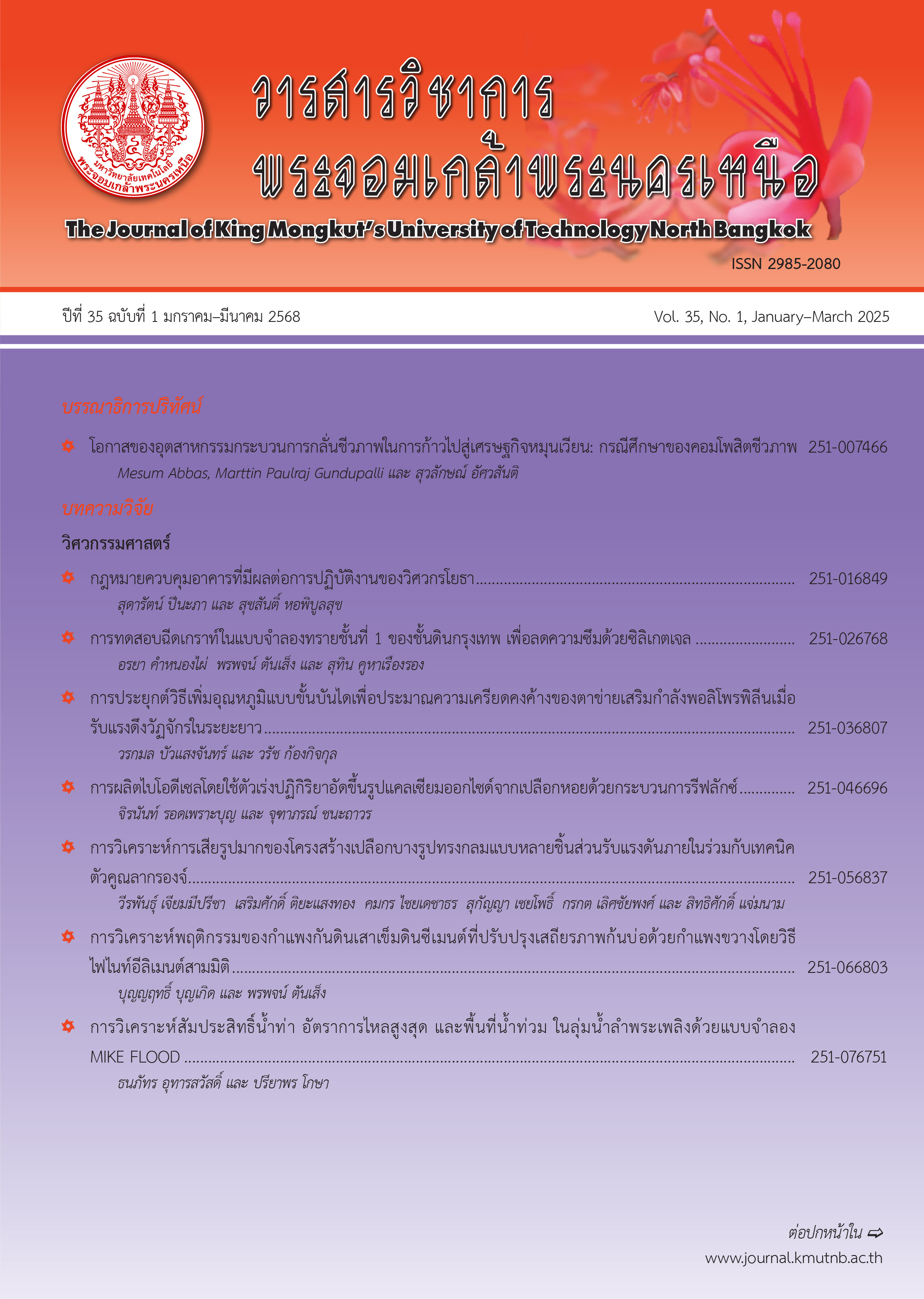การวิเคราะห์พฤติกรรมของกำแพงกันดินเสาเข็มดินซีเมนต์ที่ปรับปรุงเสถียรภาพก้นบ่อด้วยกำแพงขวางโดยวิธีไฟไนท์อีลิเมนต์สามมิติ
Main Article Content
บทคัดย่อ
บทความนี้นำเสนองานวิจัยที่ศึกษาพฤติกรรมของกำแพงกันดินเสาเข็มดินซีเมนต์ (Soil Cement Column Wall; SCCW) ที่ไม่ใช้ค้ำยันในชั้นดินเหนียวอ่อนกรุงเทพ และใช้การปรับปรุงเสถียรภาพของบ่อขุดเพื่อลดการเคลื่อนตัวของดินด้วยกำแพงขวาง (Cross Wall) และครีบยัน (Buttress) ในงานวิจัยได้ตรวจวัดการเคลื่อนตัวของ SCCW และการทรุดตัวที่ผิวดินในระหว่างการก่อสร้างอุโมงค์ทางลอดเพื่อใช้เป็นค่าเปรียบเทียบกับการจำลองด้วยวิธีไฟไนท์อีลิเมนต์ นอกจากนี้งานวิจัยนี้ได้ใช้ Interface element เพื่อจำลองความไม่สมบูรณ์ของรอยต่อระหว่าง SCC ผลการวิจัยบ่งชี้ว่า SCCW ที่ใช้ Cross wall และ Buttress มีเสถียรภาพเพิ่มขึ้นและมีการเคลื่อนตัวลดลงอย่างมีนัยสำคัญเมื่อเปรียบเทียบกับข้อมูลเชิงประสบการณ์ ผลการจำลองด้วยวิธีไฟไนท์อีลิเมนต์แสดงให้เห็นว่าค่า Young’s Modulus ของดินเหนียวอ่อนเท่ากับ 500 Su ให้ผลการวิเคราะห์การเคลื่อนตัวที่ใกล้เคียงกับผลการตรวจวัด ซึ่งสอดคล้องกับค่า Shear Modulus ที่ได้จากผลทดสอบของดินเหนียวอ่อนกรุงเทพ ผลงานวิจัยนี้สามารถนำไปประยุกต์ใช้กับการออกแบบ SCCW ที่ปรับปรุงเสถียรภาพของบ่อขุดด้วย Cross wall และ Buttress
Article Details

อนุญาตภายใต้เงื่อนไข Creative Commons Attribution-NonCommercial-NoDerivatives 4.0 International License.
บทความที่ลงตีพิมพ์เป็นข้อคิดเห็นของผู้เขียนเท่านั้น
ผู้เขียนจะต้องเป็นผู้รับผิดชอบต่อผลทางกฎหมายใดๆ ที่อาจเกิดขึ้นจากบทความนั้น
เอกสารอ้างอิง
B. Phermphorn, “Stability analysis of excavated slope stabilized by DCM column: case study and parametric analysis,” Ph.D. dissertation, Department of Civil Engineering, Kasetsart University, Bangkok, 2014 (in Thai).
W. Nutthakit, “Movement behavior of deep cement mixing column for retaining structure,” M.S. thesis, Department of Civil Engineering, Chulalongkorn University, Bangkok, 2005 (in Thai).
N. Vichit, “Behavior of soil cement column wall used for deep excavation with top-down system in Bangkok soft clay,” M.S. thesis, Department of Civil Engineering, Suranaree University of Technology, Nakhon Ratchasima, 2014 (in Thai).
S. Thanakorn and T. Pornpot, “Determination of clay stiffness with finite element method for ground movement prediction of soil-cement column wall and pile wall reinforced with soil-cement column used in deep excavation,” Technical Education Journal, vol.10, no. 3, pp. 33–47, 2019 (in Thai).
H. Ueki, S. Moue, S. Kobayshai, and K. Sekiya, “In-situ monitoring and analysis of a cut-and-cover tunnel on the bay-shore route,” Geotechnical Aspects of Underground Construction in Soft Ground, Balkema, Rotterdam, 1996.
N. Kubota, H. Sako, M. Morota, and K. Kojima, “Measure to prevent heaving during the excavation of soft ground,” Geotechnical Aspects of Underground Construction in Soft Ground, Balkema, Rotterdam, 2000.
R. Ignat, S. Baker, S. Liedberg, and S. Larsson, “Behavior of braced excavation supported by panels of deep mixing columns,” Canadian geotechnical journal, vol. 53, pp. 1671–1687. 2016.
O. Eide, G. Aas and T. Jøsang, “Special application of Cast-in-Place slurry trench walls for tunnel in soft clay in Oslo,” in Proceeding of 5th ECSMFE, Madrid, vol. 1, pp. 485–498. 1972.
C. Y. Ou, Y. L. Lin, and P. G. Hsieh, “Case record of an excavation with cross walls and buttress walls,” Journal of GeoEngineering, vol. 1, no. 2, pp. 79–86. 2006.
P. Narit, “Lateral movement analysis of cement column in excavation work,” M.S. thesis, Department of Civil Engineering, Chulalongkorn University, Bangkok, 2003 (in Thai).
H. Yoshizawa, R. Okumura, Y. Hosoya, M. Sumi and T. Yamada, “JGS TC Report: Factor affecting the quality of treated soil during excavation of DMM,” Grouting and Deep mixing, Balkema, Rotterdam, 1997.
T. Pornpot, “Instrument deep excavation in Bangkok subsoils,” M.S. thesis, Dept. Civil Eng., Asian institute of technology, Thailand, 1997.
A. I. Mana and G. W. Clough, “Prediction of movements for braced cuts in Clay”, Journal of the Geotechnical Engineering Division, vol. 107, no. 6, pp. 759 – 777, 1981.
W. Teparaksa, “Analysis of lataral wall movement for deep excavation in Bangkok subsoils,” in Proceedings of the civil and environmental engineering conference, Bangkok, pp. II-67–II-76, 1999.

